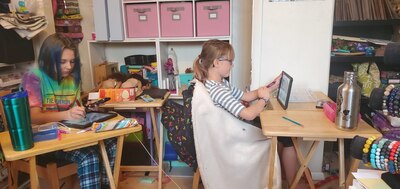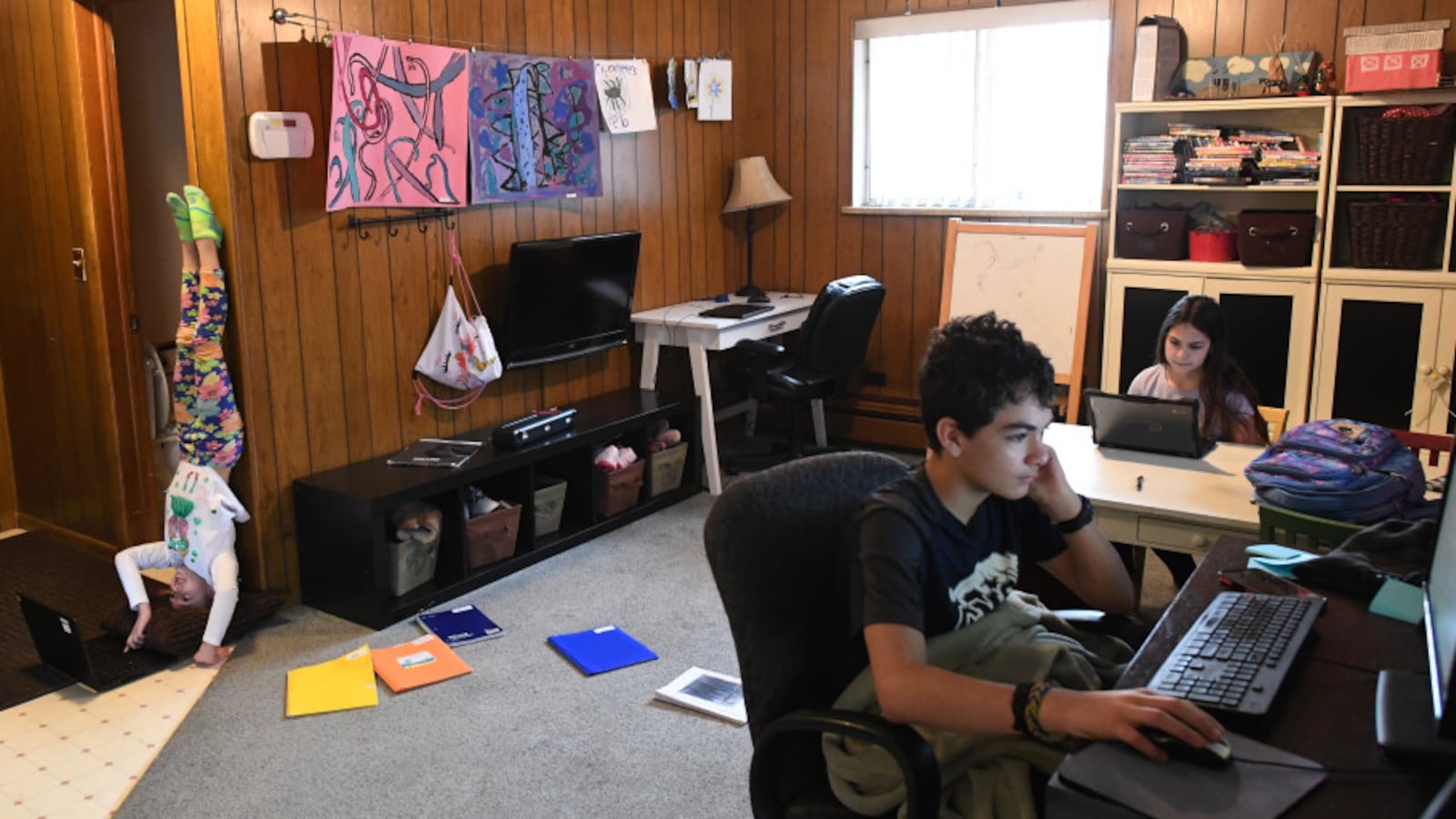After watching an online video about hippopotamuses, Xiomara Blanco’s first grade daughter was assigned to record a video of herself explaining what she learned about the massive animal.
But with limited English, she hadn’t understood much of what she heard. With Mom’s attempt to translate, she did learn the weight of the hippopotamus’ poop.
But say that on camera? “I can’t talk about that,” the girl told her mom. “That’s inappropriate.”
That’s part of how the first day of remote learning went in Blanco’s household doing remote learning through Jeffco Public Schools.
Blanco also has a fifth grader with Down syndrome who required a lot of help. Lunch was at 2 p.m. instead of noon. And Blanco didn’t end up in bed until 1:30 a.m. She appreciates that the district is trying to continue educating students, and said she understands that it’s a big adjustment, but she worries about being capable of helping her children from home.
“My husband got home and told me to relax, take it easy,” Blanco said. “But the level of stress is very high.”
Late Wednesday, Gov. Jared Polis ordered all schools closed until April 17, extending previously announced closures in most school districts. The governor encouraged districts to continue student learning during that time.
Jeffco Public Schools, Colorado’s second-largest district with about 84,000 students, had the first and most ambitious remote learning plan among large districts in the state. Other districts have said they are working on plans for remote learning. After Wednesday’s news of the extended closure, it’s more likely many will have to roll one out. Jeffco parents, teachers, and district officials say learning from home can work, despite how difficult it might be to start.
In Jeffco, the district announced its plan on Thursday to do remote learning. By Friday, teachers were giving students practice runs through the software they’d be using, and making sure all students went home with a device. The district is also working to give out hotspots to students who have no other way to access the internet.
Monday was a planning day for teachers to get their lessons ready, and by Tuesday, the district was learning virtually.
“That’s a Herculean lift in itself,” said Jeffco Superintendent Jason Glass. “I’ve been really pleased and proud.”
The district was not able to provide initial attendance figures, but Glass said reports are that many schools, including those in higher poverty neighborhoods, had more than 90% of students engaged.
But that’s not to say there haven’t been challenges. Glass said the district is still working on reaching all students. He said the district will make it happen. For any students not able to receive services, “At some point we’re going to have to come back around and make up for it somehow.”
Blanco’s son, who has Down Syndrome, did receive a virtual speech therapy session on Tuesday, but as her son navigated using the platform, and after he gave his therapist a tour of his home, Blanco said she worried the therapy only lasted some 15 minutes.
Jessica Shymkiw, who has four high schoolers with autism, has yet to hear details about how her children will continue receiving services. And she has not been able to get one of her sons to do any work from home.
“He was already struggling in high school,” Shymkiw said. “Here at home he refuses to do any work. This is like his safe space for him from schoolwork.”
Mandy Babb also had a stressful day. By 3:30 p.m. Tuesday, she said that she was ready for a full glass of wine.
“It was just super stressful,” said Babb, the mother of two girls.
Babb has two daughters, one in second grade and one in sixth grade at Lumberg Elementary in Jeffco.
Tuesday the girls got to work by 9 a.m. They set up small desks in their mom’s home office and worked on their school-issued iPads. Babb, who is launching her own business, anticipated that she wouldn’t get much work done, and so spent the day making jewelry, between helping her daughters.
Babb’s second grader was “self-sufficient” and “cheerful.” She worked on a platform called Seesaw, which Babb said was intuitive and easy for her daughter to navigate. The sixth grader had more technical difficulties, working on Google Classroom, and dealing with an older iPad that kept disconnecting from the internet.
The pair also spent time off screens, working on packets teachers sent home with students.

The girls communicated with their teachers through a chat feature. Babb said when she was trying to help her older daughter reach her teacher to troubleshoot, a lot of students were filling the class channel with selfies.
Glass said the district did not mandate whether teachers should offer live lessons, virtual group work, or individual assignments.
“We want to allow room for a lot of experimentation,” Glass said. “What we’ve asked is for our professionals to step up and take it on and figure this out. If we had tried to say this is how it needs to go, it would have been much more difficult.”
Plus, he added: “I don’t think anyone knows how to do this at this scale, so you need your professionals sharing their learning. I know my staff is learning and getting better.”
Alicia Asmus, a sixth- and seventh-grade science teacher in Jeffco, said the day went smoothly, but noted that she’s trying to help her students ease into the changes.
She prepared a video of instructions for students to watch first thing in the morning, because “the personal connections are still important.” Then she had assignments for students due in the evening — per guidance from her school for students who may have problems getting internet access or who had to manage other responsibilities at home.
She spent much of the day fielding questions and technical problems from students. Things like, “Am I doing this right?” or “I can’t get this website to work.”
“There were not a whole lot of content questions, which is kind of what I was aiming for,” Asmus said. “I didn’t want them overwhelmed.”
Generally the remote learning for teachers has meant less classroom management, she said, but has required more conversations with students about their responsibility for doing their work.
“I definitely think other districts can do it,” Asmus said. “There are so many resources out there right now.”
Kallie Leyba, a first grade teacher who is president of the AFT Colorado union in Douglas County, said in a press conference on Tuesday that all districts need to try remote learning.
“Remote teaching and learning is not a substitute for daily classroom instruction,” Leyba said. “The value is elsewhere.”
“Educators across the metro area and the country are providing structure, predictability, safety and security and a sense of normalcy for students,” Leyba said. “The presence of their teachers in students’ lives is as valuable remotely during a pandemic as it is everyday in person.”
Babb and other Jeffco parents agreed, but some wondered if the virtual communication would prove enough as closures stretch on longer.
“We’ve never not had face-to-face contact with our teachers,” Babb said, “For my older daughter and personally, that was a big adjustment.”

